2000 MERCEDES-BENZ SLK230 control arm
[x] Cancel search: control armPage 234 of 273
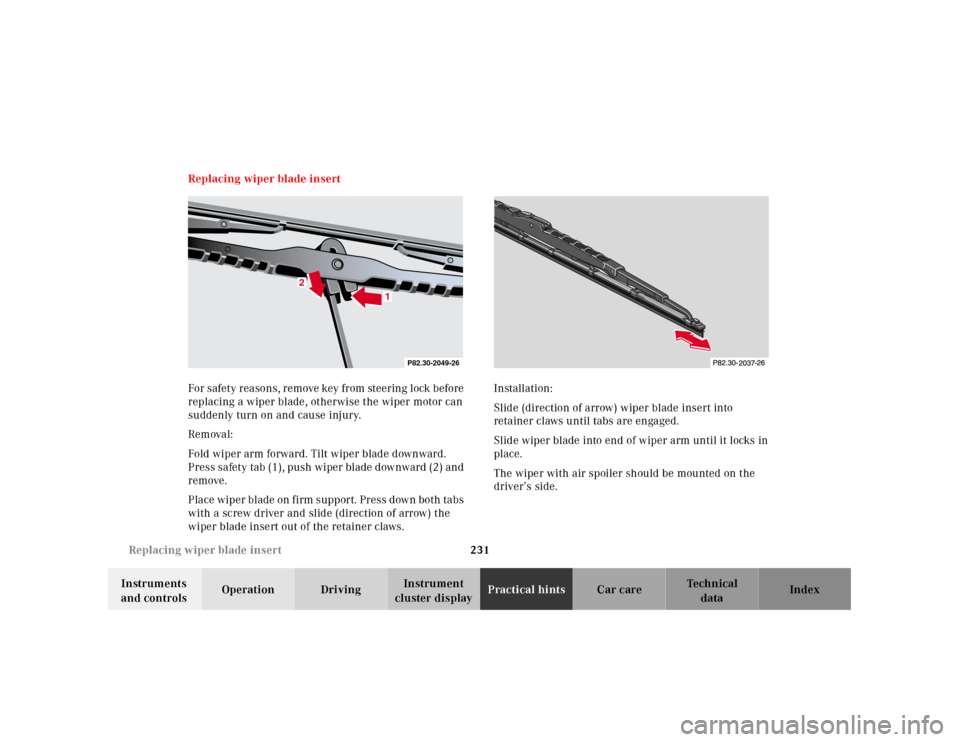
231 Replacing wiper blade insert
Te ch n ica l
data Instruments
and controlsOperation DrivingInstrument
cluster displayPractical hintsCar care Index Replacing wiper blade insert
For safety reasons, remove key from steering lock before
replacing a wiper blade, otherwise the wiper motor can
suddenly turn on and cause injury.
Removal:
Fold wiper arm forward. Tilt wiper blade downward.
Press sa fety tab (1), push wiper blade d ow nward (2) and
remove.
Place wiper blade on firm support. Press down both tabs
with a screw driver and slide (direction of arrow) the
wiper blade insert out of the retainer claws.Installation:
Slide (direction of arrow) wiper blade insert into
retainer claws until tabs are engaged.
Slide wiper blade into end of wiper arm until it locks in
place.
The wiper with air spoiler should be mounted on the
driver’s side.
2
1
P82.30-2049-26
Page 235 of 273

232 Antenna
Te ch n ica l
data Instruments
and controlsOperation DrivingInstrument
cluster displayPractical hintsCar care Index
Notes:
Do not open engine hood with wiper arms folded
forward.
Do not allow the wiper arms to contact the windshield
glass without a wiper blade inserted. The glass may be
scratched or broken.
Make certain that the wiper blade is properly installed.
An improperly installed wiper blade may cause
windshield damage.
Antenna
To prevent damage or diminished radio reception after
reinstallation, the non-retractable antenna should not
be removed. The antenna is automatic car-wash safe.Manual release of fuel filler flap
The manual release knob is located behind cover (1) in
the right slide trunk panel.
In case the central locking system does not release the
fuel filler flap, pull the manual release knob (arrow)
while simultaneously opening the fuel filler f lap.
1
P80.20-2110-26
Page 241 of 273

238 Cleaning and care of the vehicle
Te ch n ica l
data Instruments
and controlsOperation DrivingInstrument
cluster displayPractical hintsCar careIndex
Prior to cleaning the inside of the rear window, operate
hardtop via the switch until rear shelf (1) is in a vertical
position. Leave key in steering lock position 2.
The roof will remain in this position for approximately
7 minutes, sufficient time for cleaning the inside of the
rear window.Wiper blades
Clean the wiper blade rubbers with a clean cloth and
detergent solution.
Light alloy wheels
Mercedes-Benz approved Wheel Care should be used for
regular cleaning of the light alloy wheels.
If possible, clean wheels once a week with
Mercedes-Benz approved Wheel Care, using a soft
bristle brush and a strong spray of water.
Follow instructions on container.
Note:
Use only acid-free cleaning materials. The acid could
lead to corrosion.
Instrument cluster
Use a gentle dishwashing detergent or mild detergent
for delicate fabrics as a washing solution. Wipe with a
cloth moistened in lukewarm solution. Do not use
scouring agents.
Page 242 of 273
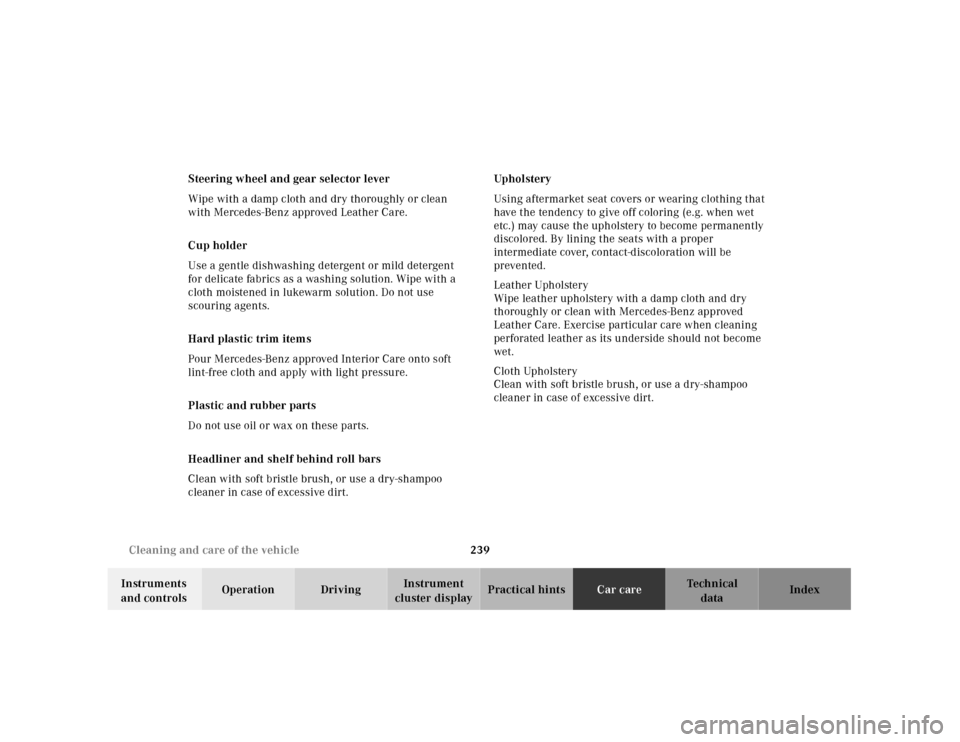
239 Cleaning and care of the vehicle
Te ch n ica l
data Instruments
and controlsOperation DrivingInstrument
cluster displayPractical hintsCar careIndex Steering wheel and gear selector lever
Wipe with a damp cloth and dry thoroughly or clean
with Mercedes-Benz approved Leather Care.
Cup holder
Use a gentle dishwashing detergent or mild detergent
for delicate fabrics as a washing solution. Wipe with a
cloth moistened in lukewarm solution. Do not use
scouring agents.
Hard plastic trim items
Pour Mercedes-Benz approved Interior Care onto soft
lint-free cloth and apply with light pressure.
Plastic and rubber parts
Do not use oil or wax on these parts.
Headliner and shelf behind roll bars
Clean with soft bristle brush, or use a dry-shampoo
cleaner in case of excessive dirt.Upholstery
Using aftermarket seat covers or wearing clothing that
have the tendency to give off coloring (e.g. when wet
etc.) may cause the upholstery to become permanently
discolored. By lining the seats with a proper
intermediate cover, contact-discoloration will be
prevented.
Leather Upholstery
Wipe leather upholstery with a damp cloth and dry
thoroughly or clean with Mercedes-Benz approved
Leather Care. Exercise particular care when cleaning
perforated leather as its underside should not become
wet.
Cloth Upholstery
Clean with soft bristle brush, or use a dry-shampoo
cleaner in case of excessive dirt.
Page 243 of 273
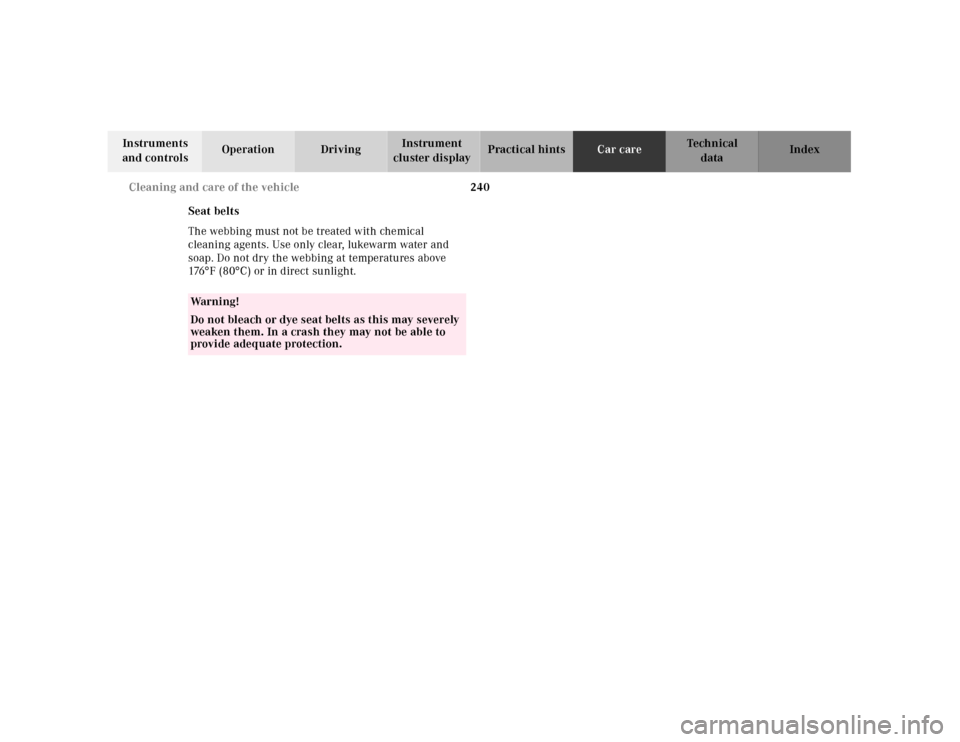
240 Cleaning and care of the vehicle
Te ch n ica l
data Instruments
and controlsOperation DrivingInstrument
cluster displayPractical hintsCar careIndex
Seat belts
The webbing must not be treated with chemical
cleaning agents. Use only clear, lukewarm water and
soap. Do not dry the webbing at temperatures above
176°F (80°C) or in direct sunlight.
Wa r n i n g !
Do not bleach or dye seat belts as this may severely
weaken them. In a crash they may not be able to
provide adequate protection.
Page 257 of 273
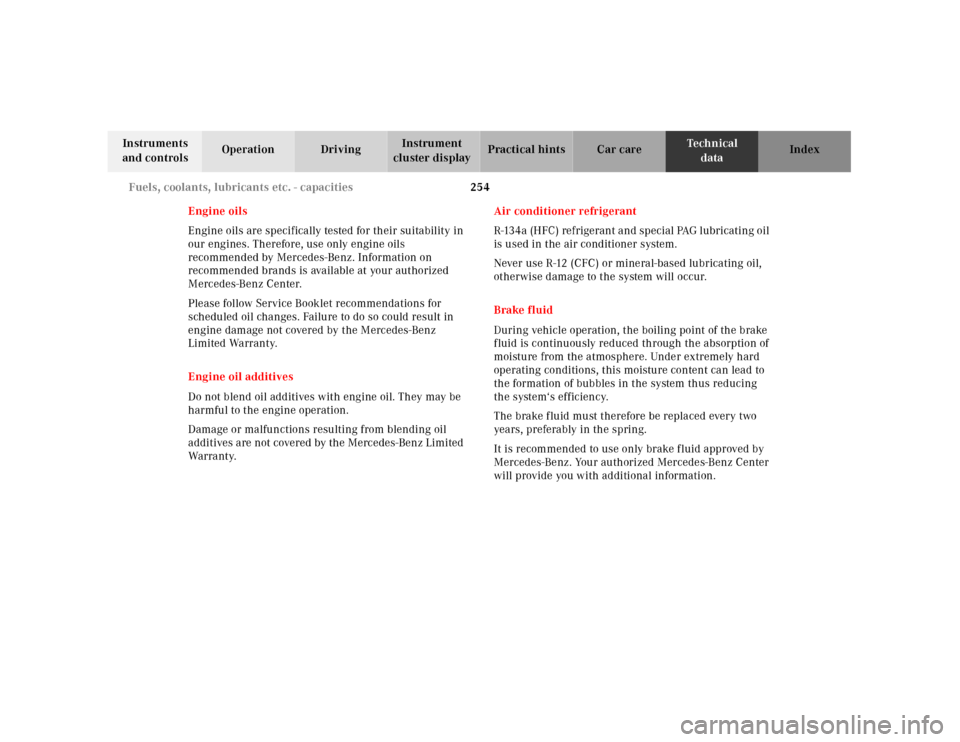
254 Fuels, coolants, lubricants etc. - capacities
Te ch n ica l
data Instruments
and controlsOperation DrivingInstrument
cluster displayPractical hints Car care Index
Engine oils
Engine oils are specifically tested for their suitability in
our engines. Therefore, use only engine oils
recommended by Mercedes-Benz. Information on
recommended brands is available at your authorized
Mercedes-Benz Center.
Please follow Service Booklet recommendations for
scheduled oil changes. Failure to do so could result in
engine damage not covered by the Mercedes-Benz
Limited Warranty.
Engine oil additives
Do not blend oil additives with engine oil. They may be
harmful to the engine operation.
Damage or malfunctions resulting from blending oil
additives are not covered by the Mercedes-Benz Limited
War ra nt y.Air conditioner refrigerant
R-134a (H FC) ref rigerant a nd special PAG l ubricating oil
is used in the air conditioner system.
Never use R-12 (CFC) or mineral-based lubricating oil,
otherwise damage to the system will occur.
Brake fluid
During vehicle operation, the boiling point of the brake
fluid is continuously reduced through the absorption of
moisture from the atmosphere. Under extremely hard
operating conditions, this moisture content can lead to
the formation of bubbles in the system thus reducing
the system‘s efficiency.
The brake fluid must therefore be replaced every two
years, preferably in the spring.
It is recommended to use only brake fluid approved by
Mercedes-Benz. Your authorized Mercedes-Benz Center
will provide you with additional information.
Page 259 of 273
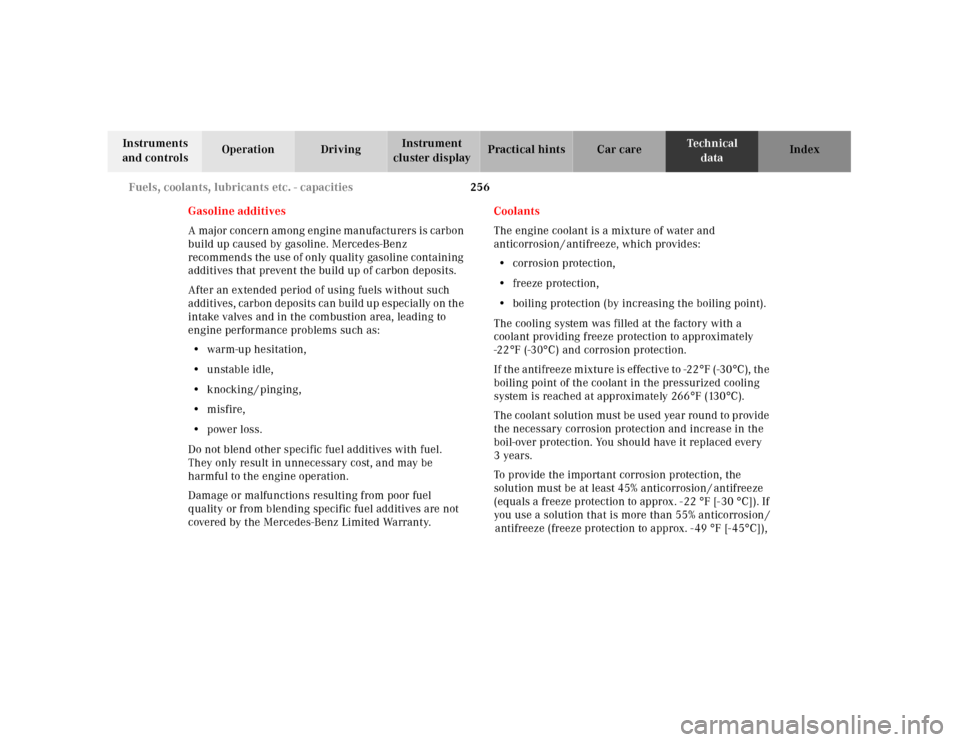
256 Fuels, coolants, lubricants etc. - capacities
Te ch n ica l
data Instruments
and controlsOperation DrivingInstrument
cluster displayPractical hints Car care Index
Gasoline additives
A major concern among engine manufacturers is carbon
build up caused by gasoline. Mercedes-Benz
recommends the use of only quality gasoline containing
additives that prevent the build up of carbon deposits.
After an extended period of using fuels without such
a d d i t i ve s , c a r b o n d e po si t s c a n b u il d u p e s pe c ia l ly o n t h e
intake valves and in the combustion area, leading to
engine performance problems such as:
•warm-up hesitation,
•unstable idle,
•knocking / pinging,
•misfire,
•power loss.
Do not blend other specific fuel additives with fuel.
They only result in unnecessary cost, and may be
harmful to the engine operation.
Damage or malfunctions resulting from poor fuel
quality or from blending specific fuel additives are not
covered by the Mercedes-Benz Limited Warranty.Coolants
The engine coolant is a mixture of water and
anticorrosion / antifreeze, which provides:
•corrosion protection,
•freeze protection,
•boiling protection (by increasing the boiling point).
The cooling system was filled at the factory with a
coolant providing freeze protection to approximately
-22°F (-30°C) and corrosion protection.
If the antifreeze mixture is effective to -22°F (-30°C), the
boiling point of the coolant in the pressurized cooling
system is reached at approximately 266°F (130°C).
The cool ant sol ution must be used yea r round to provide
the necessary corrosion protection and increase in the
boil-over protection. You should have it replaced every
3years.
To provide the important corrosion protection, the
solution must be at least 45% anticorrosion / antifreeze
(equals a freeze protection to approx. - 22 °F [- 30 °C]). If
you use a solution that is more than 55% anticorrosion /
antifreeze (freeze protection to approx. - 49 °F [- 45°C]),
Page 263 of 273

260 Index
Te ch n ica l
data Instruments
and controlsOperation DrivingInstrument
cluster displayPractical hints Car careIndex
Index
A
ABS (Antilock brake system) ....................................... 168
Malfunction indicator lamp ..................................... 182
Adjusting telescoping steering column ........................ 63
Air conditioner refrigerant ...........................................254
Air pump ......................................................................... 196
Airbag deactivation system ............................................ 50
AIRBAG OFF indicator lamp ........................................ 185
Airbags .............................................................................. 52
Alarm system ............................................................. 35, 37
Antenna ...........................................................................232
Anticorrosion / antifreeze .................. 161, 194, 252, 256
Antilock brake system (ABS) ....................................... 168
Malfunction indicator lamp ..................................... 182
Antitheft alarm system ................................................... 35
Aquaplaning ................................................................... 158
Ashtrays ...........................................................................114
Audio system .................................................................... 91
Anti-theft system ........................................................ 93
Button and soft key operation ................................... 94
Cassette mode ............................................................. 99
CD changer ................................................................ 103CD mode ..................................................................... 102
Operating and display elements ...............................92
Operating safety .......................................................... 91
Operation – audio and telephone ............................. 91
Radio mode .................................................................. 97
Telephone operation .................................................106
Automatic central locking .............................................. 31
Automatic transmission ................................................144
Emergency Operation ............................................... 152
Fluid level ................................................................... 192
Program mode selector switch ................................ 151
Selector lever positions ............................................147
Transmission selector lever,
manually unlocking ............................................. 217
BBabySmart
TM airbag deactivation system ..................... 50
Self-test ......................................................................... 51
BAS (Brake assist system) ............................................ 166
Malfunction indicator lamp ..................................... 181
Battery ............................................................................. 210
Charge indicator lamp .............................................. 184
Recycling .................................................................... 211
Block heater .................................................................... 162